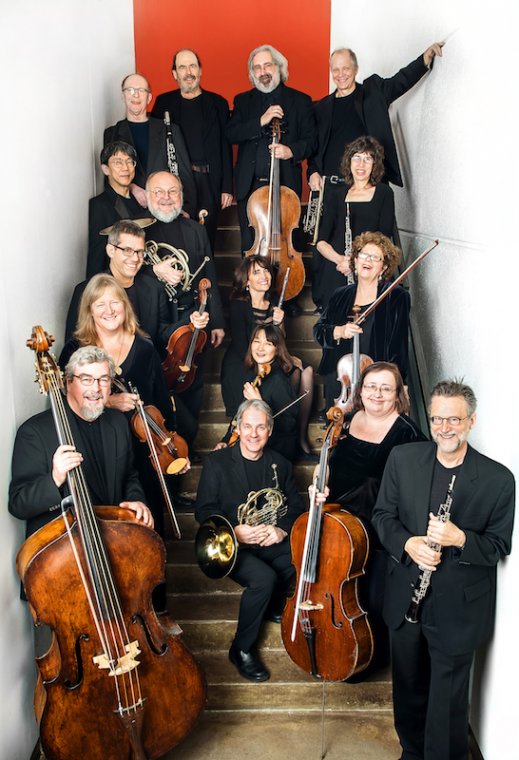St. Luke’s Venetian chamber program rocks the Baroque boat

The St. Luke’s Chamber Ensemble performed Tuesday night at Merkin Hall. Photo: Matt Dine
Although the title of the concert by the Orchestra of St. Luke’s Chamber Ensemble, “Vivaldi, Venice, & the Influence of Italy,” sounded like an escapee from a college catalogue, there was nothing dry or academic about the performances that shook, rattled, and rolled Merkin Hall Tuesday night.
Formerly a mighty naval and commercial power, Venice carried on into the Renaissance and Baroque eras as Europe’s window on the East, an artistic melting pot, and (as the concert’s unsigned program notes succinctly put it) “an epicenter of excitement, pleasure, and excess.” One would expect vital and dazzling music to come from such a place, and Tuesday’s concert proved that point many times over.
Sonatas and concertos by Venice’s favorite son, Antonio Vivaldi, alternated on the bill with works by his precursors Monteverdi, Merula, Biber, and Corelli, who all helped spread the Italian style far and wide.
In advance publicity but, oddly, not mentioned in Tuesday’s printed program, this lineup of works was described as inspired by Venetian artworks currently on exhibit at New York’s Pierpont Morgan Library and Museum, where this program will be repeated Wednesday. Direct connections weren’t obvious, but certainly the vibrant humanism of Pontormo’s alterpiece and the drawings of Tintoretto and his school had its analogue in these expressive pieces.
This Venice 101 program began at the beginning, with excerpts from Monteverdi’s landmark opera L’Orfeo. The strings-and-continuo ensemble delivered a convincing fanfare in the familiar Toccata, answering themselves immediately in a silky ritornello. The Sinfonia accompanying Orpheus’s descent into the underworld sounded appropriately veiled and suspenseful.
The two dance movements, one for a chorus of nymphs and shepherds, the other a hopping moresca (Moorish dance), were driven by the incisive playing of cellist Myron Lutzke, double bassist John Feeney, and harpsichordist Robert Wolinsky– the basso continuo as rhythm section. This group, sometimes reinforced by Louise Schulman on the lute-like cittern, kept many an up-tempo movement on the go during the evening.
Vivaldi’s Cello Sonata in B flat major, RV 46, showcased the agility and imagination of cellist Lutzke as it alternated introspective slow movements with a catchy dance tune and a fleet-fingered finale. Lutzke cultivated a dark, “period” sound on what appeared to be a present-day cello.
In contrast, Krista Bennion Feeney’s violin sang out boldly in Heinrich von Biber’s Italian-influenced Sonata No. 3 in F major, as frequent double-stop passages and rapid arpeggios piled up the sound waves still more. Two variation movements, one lightly dancing and the other in powerful chaconne style, offered expressive worlds to explore, and Bennion Feeney did so with gusto.
The addition of a second violin to the sonata group opened up another dimension in Vivaldi’s Trio Sonata in B minor, RV 79, as Bennion Feeney and Mitsuru Tsubota chased each other in tight circles to open the piece, then turned up the heat still further in a racing Corrente, a Gigue with glittering embellishments, and a Gavotte whose minor key and snazzy variations put one in mind of a Paganini caprice.
Although Tarquinio Merula was a younger contemporary of Monteverdi, his Ciaconna (chaconne) had a transparent, almost style galant feel to it that seemed about a hundred years ahead of its time. Perhaps that’s because its repeating ground bass was introduced solo by Schulman and her gentle cittern, before the rest of the continuo and finally the whole ensemble joined in. Far from just plunking along under the two violins, the continuo asserted itself often with vigorous variations of its own, to delightful effect.
The concert closed with a musical sandwich of contrasting ingredients, two Vivaldi ripieno concertos (no designated soloist, but an ensemble effort) flanking one of the most showy and soloistic of Baroque pieces, Arcangelo Corelli’s “La Folia” Sonata for Violin and Continuo, Op. 5, No. 12.
“Ripieno” means full, and with Bennion Feeney leading the way and Schulman now joining in on the viola, even with just one instrument to a part the ensemble produced a splendid, room-filling sound. Vivaldi’s Concerto in C major, RV 117, was rich in lively interactions among the players, and closed with a bustling movement that charmed the ear with phrases of unpredictable length.
Corelli was the preeminent violin virtuoso of his time, and it shows in the “La Folia” Sonata. The title means “madness,” and although it’s actually the name of the old song Corelli is varying here, the piece is also crazy difficult to play. After violinist Tsubota successfully navigated all the dazzling scales, leaps and double stops, it seems churlish to suggest the variations could have had, well, more variety in tone and character, but that is what one wished for in this otherwise able performance.
The full ensemble returned to put an exclamation point on the evening with Vivaldi’s intricate and energetic Concerto in G minor, RV 157. Following yet another chaconne (this one on an expressively descending bass line) and a Largo with delicate imitation between the parts, a bracing Allegro with blazing scales for all instruments (including the double bass) brought the concert to a thrilling, sonorous close.
The program will be repeated 7:30 p.m. Wednesday at the Morgan Library & Museum and 2 p.m. Sunday at the Brooklyn Museum. oslmusic.org; 212-594-6100, Ext. 2.